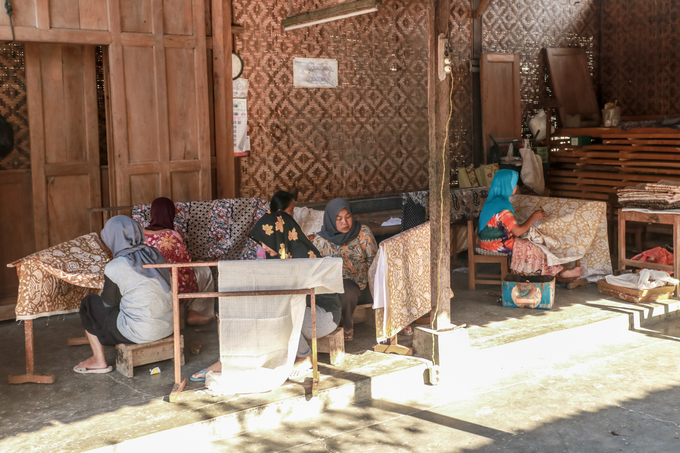Craft batik fabric hundreds of years old
INDONESIA Artisans use molten beeswax to paint on patterns to create patterns, in which the most sophisticated lines are only one millimeter wide.

Visitors to Giriloyo village in Yogyakarta area will see women attentively drawing elaborate motifs on the white canvas, next to a small kitchen with a bowl of molten beeswax. They are making batik, a famous Indonesian wax-dyed fabric, which has been recognized by UNESCO as a world intangible cultural heritage since 2009.
Imaroh, 51 years old, is a longtime female artisan in the village who has been with the job since the age of 10. Like Imaroh, most women in the village make batik almost their whole life. “I am the third generation to make batik. Up to now, my daughter is also pursuing this work, ”Imaroh said.

Tools for drawing a bowl-like bowl with a short wooden handle, called "canting" in the vernacular. Most of the motifs are pre-sketched on charcoal or lead fabric before pouring wax. Traditional batik motifs have been handed down for generations. Very few artisans can draw directly with wax without pre-existing sketches.

Canting set for drawing on fabric. Canting has different sizes numbered accordingly. Minimum nozzle diameter from one mm to make detailed strokes, besides the larger taps to fill large gaps.

The female artist blows the canting to remove impurities on the nozzle. The heated liquid is a mixture of beeswax mixed with several other substances. Artisans keep the wax solution in moderation to create the desired texture.

The traditional colors for batik in this area include beige, green, brown and black, made from natural ingredients such as leaves, bark, and sap. Today, many places in Indonesia use both chemical dyes for their convenience and cheap price.

Batik is produced in many parts of Indonesia with different motifs. However, Giriloyo is one of the few places where artisans produce completely handmade, with the same techniques and textures hundreds of years ago. Throughout the village there are about 900 batik producers, accounting for nearly one third of the local population. The artisans here are aged from 20 to 80.

Men take a few roles in the profession of batik making because it requires patience and meticulous suitability for women. Usually, they only undertake the process of dyeing and marketing products.
A batik cloth usually goes through 12 stages to complete, with a combination of 3-4 artisans. Due to the complicated and time-consuming process, handmade batiks cost more than mass-produced industrial fabrics.

Imaroh also owns a batik gallery. She said that in the 17th century, the king of Yogyakarta had a royal palace complex and tomb complex built in Imogiri. Hundreds of servants in the palace and their families have moved here to protect the complex. At that time, men served in the palace, while women at home made batik. Until now, the women here are still happy to do this job. Thanks to batik, I have money for my children to go to college, ”Imaroh said.
Imaroh batiks cost between 250,000 and 3 million rupiah (approximately VND 400,000 - 5 million) depending on the complexity of the pattern and the quality of the fabric. The cloth can be used to make skirts, sarongs to wear in special events.

Giriloyo is planned to become a tourist village in 2010. Martini, 39, another group leader, said that domestic and foreign tourists coming to the village also learn how to make batik besides shopping. Each year, about 2,500 visitors take part in batik making classes here, mainly students in the area. "This is a way to revitalize village tourism, as well as our effort to conserve batik," she said.

The most famous place to buy batik is Beringharjo Market, you can bargain to get the best price from the seller. In addition, visitors buy batik in galleries in Giriloyo village, with textures not available on the market.
Rara Fitri, a tourist said, the trip to Giriloyo helped her expand her knowledge of traditional batik. In addition to shopping, she witnessed and learned some stages of the creative process on fabrics. "Interesting. I know the history of batik development to the philosophical significance of each motif, ”she said.
- People living in the 'safest' places in the world
- The 'fairy' once tricked author Sherlock Holmes
- The code led the British to hunt down 'golden rabbit treasures' 40 years ago
- The 'glass princess' was always afraid of crumbling in 19th-century Europe
- A series of pictures of anatomy with a dark past in Nazi Germany
FIDITOUR TRAVEL COMMUNICATION COMPANY
Representative: Mr. Tran Van Long - Chairman and General Director
Head office: 95B-97-99 Tran Hung Dao, District 1, City. Ho Chi Minh.
Hanoi Branch: 66 Tran Hung Dao, Hoan Kiem District, Hanoi
Phone: 028 730 56789 | Hotline: 19001177